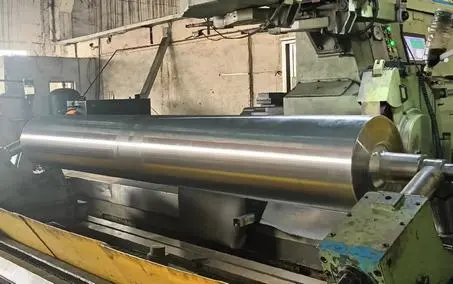The Function and Importance of Stabilizer Rolls in Slitting Operations
Material Tension Control
One of the primary functions of stabilizer rolls is to maintain proper tension on the material being slit. These rolls work in conjunction with other components of the slitting line to ensure that the material remains taut and flat as it moves through the cutting process. By providing consistent tension, stabilizer rolls help prevent wrinkles, folds, or slack areas that could lead to uneven cuts or material damage. This tension control is particularly crucial when dealing with delicate or thin materials that are prone to distortion or tearing.
Vibration Reduction
Vibration can be a significant issue in slitting operations, especially when working with high-speed lines or processing materials with varying thicknesses. Stabilizer rolls are designed to dampen these vibrations, creating a more stable environment for the slitting process. By minimizing vibrations, these rolls help maintain the accuracy of the cuts and reduce the risk of defects or inconsistencies in the final product. This vibration reduction capability is especially valuable in industries where precision is paramount, such as electronics manufacturing or medical device production.
Improved Cut Quality
The implementation of stabilizer rolls directly contributes to improved cut quality in slitting operations. By providing a stable platform for the material and maintaining proper tension, these rolls ensure that the cutting blades can perform their function with maximum efficiency. This results in cleaner, more precise cuts with minimal burrs or rough edges. The enhanced cut quality not only improves the appearance and functionality of the end product but also reduces the need for secondary finishing operations, saving time and resources in the production process.
Design Considerations for Effective Stabilizer Rolls
Material Selection
The choice of material for stabilizer rolls is critical to their performance and longevity. High-quality stabilizer rolls are typically constructed from durable materials such as hardened steel, chrome-plated steel, or specialized alloys. These materials are selected for their wear resistance, dimensional stability, and ability to maintain a smooth surface finish over extended periods of use. In some applications, rolls may be coated with materials like polyurethane or rubber to provide additional grip or protect delicate materials from damage during the slitting process.
Surface Finish and Precision
The surface finish of stabilizer rolls plays a significant role in their effectiveness. A smooth, precisely machined surface helps minimize friction and ensures uniform contact with the material being processed. Many stabilizer rolls undergo specialized finishing processes, such as grinding or polishing, to achieve the required surface characteristics. The level of precision in the roll's dimensions and roundness is also crucial, as even slight deviations can lead to inconsistencies in the slitting process. Manufacturers often employ advanced machining techniques and quality control measures to ensure that stabilizer rolls meet the exacting standards required for optimal performance.
Bearing and Mounting Systems
The bearing and mounting systems used in stabilizer rolls are essential components that impact their overall functionality. High-quality bearings are necessary to ensure smooth rotation and minimize vibration, even at high speeds. The mounting system must be designed to allow for easy installation and removal of the rolls for maintenance or replacement. Additionally, some advanced stabilizer roll designs incorporate adjustable mounting systems that allow for fine-tuning of the roll position to accommodate different material thicknesses or processing requirements. These design considerations contribute to the versatility and longevity of stabilizer rolls in various slitting applications.
Maintenance and Optimization of Stabilizer Rolls for Peak Performance
Regular Inspection and Cleaning
To ensure the continued effectiveness of stabilizer rolls, regular inspection and cleaning are essential. Operators should visually inspect the rolls for signs of wear, damage, or material buildup on a routine basis. Any irregularities in the roll surface, such as scratches, dents, or uneven wear patterns, should be addressed promptly to prevent issues in the slitting process. Cleaning the rolls regularly helps maintain their surface properties and prevents the accumulation of debris that could affect their performance. Depending on the materials being processed, specialized cleaning techniques or products may be required to remove residues without damaging the roll surface.
Alignment and Balancing
Proper alignment and balancing of stabilizer rolls are crucial for optimal performance in slitting operations. Misaligned or unbalanced rolls can lead to uneven material tension, vibration, and inconsistent cut quality. Regular checks should be performed to ensure that the rolls are correctly aligned with other components in the slitting line. Dynamic balancing of the rolls may be necessary, especially for high-speed applications, to minimize vibration and ensure smooth operation. Some advanced slitting systems incorporate in-line monitoring and adjustment capabilities to maintain proper roll alignment and balance during operation.
Timely Replacement and Upgrades
Even with proper maintenance, stabilizer rolls will eventually wear out and require replacement. It's important to establish criteria for determining when rolls should be replaced based on factors such as surface condition, dimensional accuracy, and overall performance. Proactive replacement of worn rolls can prevent quality issues and unplanned downtime. When replacing stabilizer rolls, consider upgrading to newer designs or materials that may offer improved performance or longevity. Staying informed about advancements in stabilizer roll technology can help optimize slitting operations and maintain a competitive edge in production capabilities.
In conclusion, stabilizer rolls are indispensable components in the slitting process, providing the stability and control necessary for high-quality, efficient operations. By understanding their function, design considerations, and maintenance requirements, manufacturers can maximize the benefits of these crucial components in their production lines. For more information about stabilizer rolls and other metal parts used in various industries, please contact us at info@welongpost.com.




